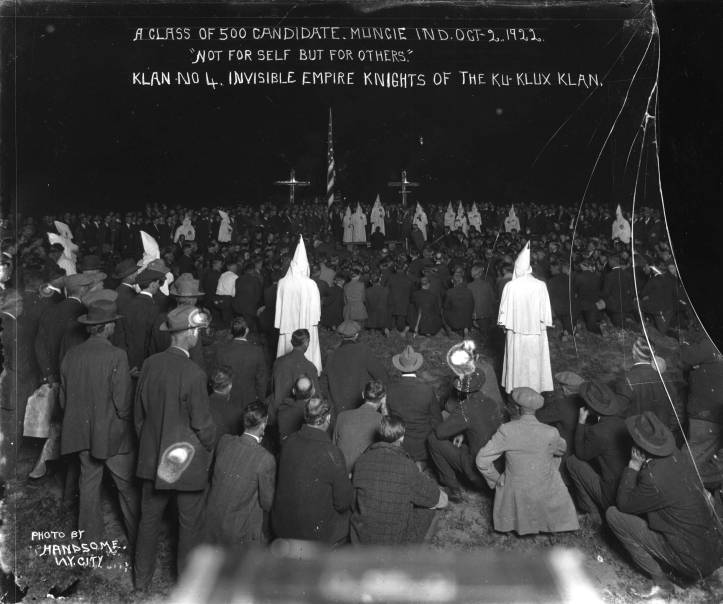The Ku Klux Klan

The Ku Klux Klan, often referred to as "the Klan" or "the KKK", while not directly tied to government actions like the rest of the topics in the Suppressed American Wrongs section, is a prominent stain on the slate of the United States, which historically, and still to this day, threaten the livelihood and safety of black communities, as well as other minority groups. The formation of the Klan dates back almost 150 years, and because of its long history, and great impact it has had on many populations, its story is important to tell (Parsons, 2015). In order for archivists to work toward and achieve neutrality, and to advocate for those who have had their voices silenced, the stories of radical groups such as the Klan, as well as the stories of those who were impacted by these groups, must be told.
The Ku Klux Klan has had three waves of activity since their foundation in 1866, all of which have been focused on the rights of the black population. The first wave of the Klan was created by six Confederate veterans, who were focused on rebuilding the southern culture from before the black population was freed and began to integrate into, and participate in, communities (Parsons, 2015). Though there was much violence towards the black population surrounding the founding of the Klan, the first verified violent act by the Klan towards a black individual occurred in 1868, with their existence becoming a national movement in the following years (Parsons, 2015). As the movement became national, Congress eventually stepped in, speaking with witnesses of the violence the Klan had been committing against black free individuals. After determining the oppressive and violent acts of the Klan, the government began to suppress the Klan, and by 1872 their public presence had died out (Parsons, 2015).
Unfortunately, the Ku Klux Klan reemerged from 1915 to the 1930s, with the goal "to achieve pan-Protestantism, meaning the pursuit for uniting white, native-born, Protestant Americans seeking to uphold white Protestant hegemony" (Forsell, 2020, p. 237). This wave focused on the threat that the black population posed against this "pure American idea." With its focus on Protestantism, this wave was much more widespread than the previous movement, with at least 30,000 Protestant pastors being a part of the Klan by 1924, and the Klan having an estimated peak membership of four to six million (Frosell, 2020). The second wave of the Klan died down in the 1930s due to both internal conflicts between leaders, and further government suppression (Frosell, 2020; Lewis, 2013).
The third wave of the Ku Klux Klan arose in the 1950s and 1960s, with many independent local groups working to oppose civil rights movements and desegregation, as opposed to a national organization like the previous wave. Because the Klan was functioning through local chapters, where communities were more tight knit, these chapters were also able to build positive relationships with many southern law enforcement officers (McWhorter, 2013). After the 1963 bombing of the 16th Street Baptist Church, which took the lives of four young girls, the govenment began to take the threats of the Klan against the black community more seriously (Hewitt, 2005). In 1965, the House Un-American Activities Committee (HUAC) began investigating the Klan's activities, and unlike previous investigations into the Klan, found that the Klan was considered an "un-American" group that practiced terrorism and violence (Lewis, 2013). With them being deemed a terrorist organization, they thus began to lose supporters, and became overshadowed by other important moments in history.
Collections Detailing the Ku Klux Klan
Ku Klux Klan Collection (RL.10138), David M. Rubenstein Rare Book & Manuscript Library, Duke University, Durham, North Carolina.
The Ku Klux Klan Collection contains materials from all three waves of the Klan's activities. This collection includes ephemera associated with the first Klan, such as pamphlets and flyers. Materials associated with the second Klan include materials associated with the Women of the Ku Klux Klan group. The third Klan materials represent the Klans from the Southeast and mid-Atlantic States, and include literature and materials handouts on Klan history and their goals as a group.
George R. Dale Papers (MSS-045), Archives and Special Collections, Ball State University, Muncie, Indiana.
The George R. Dale Papers contain materials associated with Dale's fight against the second Klan wave. Dale, the mayor of Muncie, Indiana editor and publisher of the Post-Democrat, was known nationally for fighting against the Klan's influence on local politics in Muncie. This collection includes correspondence and warnings to Dale from the Klan, as well as printed materials from the Klan, and newspaper clippings about Dale's work.
R. L. Hanvey Collection (MSS-0624), W.S. Hoole Special Collections, University of Alabama, Tuscaloosa, Alabama.
The R. L. Hanvey Collection consists of materials collected by Hanvey during his time as a Klan member during the second wave. These materials include the 5th edition of "The Kloran", which was the Klan handbook. It also includes a photo of Alabama Women of the Ku Klux Klan, and a wallet with the Klan seal.